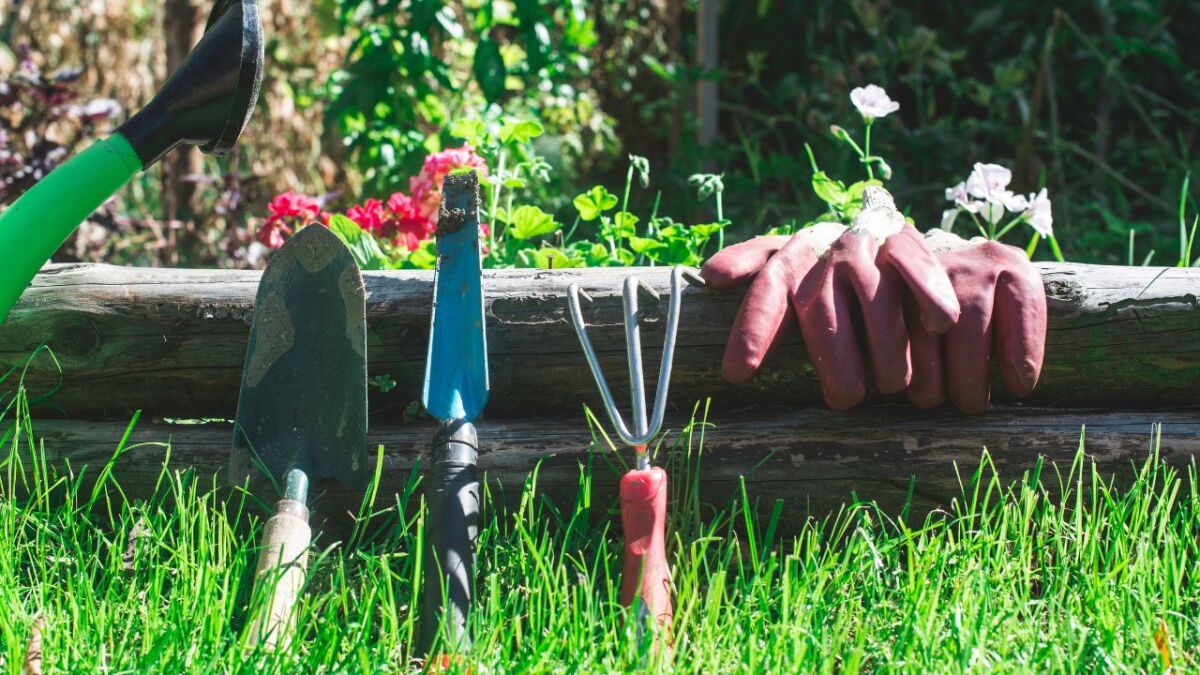
With these essential gardening tools and tricks, you will get through the self-sufficient gardening year well
👉 The key facts from this guide
- Choose the right tools: shovel, spade, rake, hoe, pruning shears, watering can, and compost bin.
- Maintain and care for your garden tools regularly to extend their lifespan.
- Use a small shovel for precise work and a spade for larger tasks.
- Loosen and smooth the soil with a rake and hoe to create optimal growing conditions.
- Protect your hands, knees, and head while gardening and take sufficient breaks and hydration.
- Consider a compost bin to produce nutrient-rich soil for your garden and live more sustainably.
Do you intend to build and create your own self-sufficient garden?
Then you should also make a list of the things you need for successful gardening.
The list will help you to orient yourself and make it easier and better to memorize the following paragraphs.
You will see, you don't need much to make the gardening year a success.
The necessary items are the right shoes, shovel and spade, rake and hoe, a garden shear, a composter, and definitely protection for your hands, knees, and head.
In addition, a watering can should not be missing.
But let's go through everything step by step so that you also know the related tricks that will make your work in the garden easier.
Tool-Time: The right tool is essential
First: To keep your garden tools well-maintained, you need to familiarize yourself with their characteristics. Every good craftsman knows his tools.
A shovel can become dull just like a saw, so it needs to be checked and sharpened occasionally.
Loose fittings at Hacke, Harke and Co will unnecessarily complicate your work. Additionally, it's annoying in the long run when everything wobbles, and you don't know when it will finally fall apart.
Therefore, make sure to always clean and inspect your garden tools. This way, you can keep an eye on whether your equipment is in good condition.
Small and large shovel
A small shovel is often even more important than a large shovel next to the spade. While the latter is more used for preparations in spring or autumn, the small one is needed quite frequently for planting, repotting or hilling.
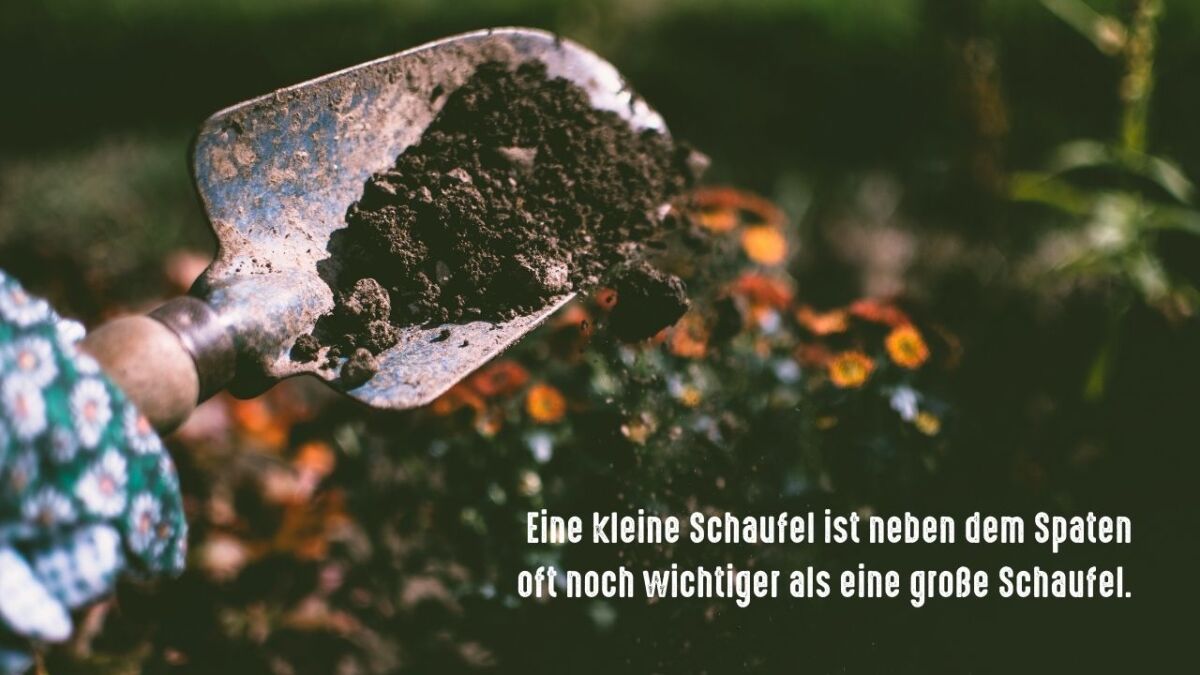
It is very handy. Especially in greenhouses, where space is generally limited, it is an indispensable tool. The same applies to other small garden tools. Rake, hoe, and claw are also available in miniature versions with a short handle and a smaller attachment.
You are more agile with it and can work precisely on just sprouted plants without causing any damage to the seedlings.
The spade is undoubtedly one of the most essential tools ever. It is indispensable for digging and excavating beds, for creating them, and for cutting stubborn roots.
My recommendation for a small shovel is the Gardena Classic Trowel or the Fiskars Trowel, and for garden spades, I recommend the Fiskars Gardener's Spade or the Fiskars Garden Tool Set (pointed and flat shovel).
Rake and the Hoe
You need the rake and the hoe to loosen and smooth the soil.
Compacted soil hardly allows water and nutrients to penetrate deeper layers. That's why it's important to occasionally loosen the soil (read here how to determine the soil type). Large clumps of soil become as hard as stone during prolonged drought. This not only makes the work more difficult, but also hinders cultivation.
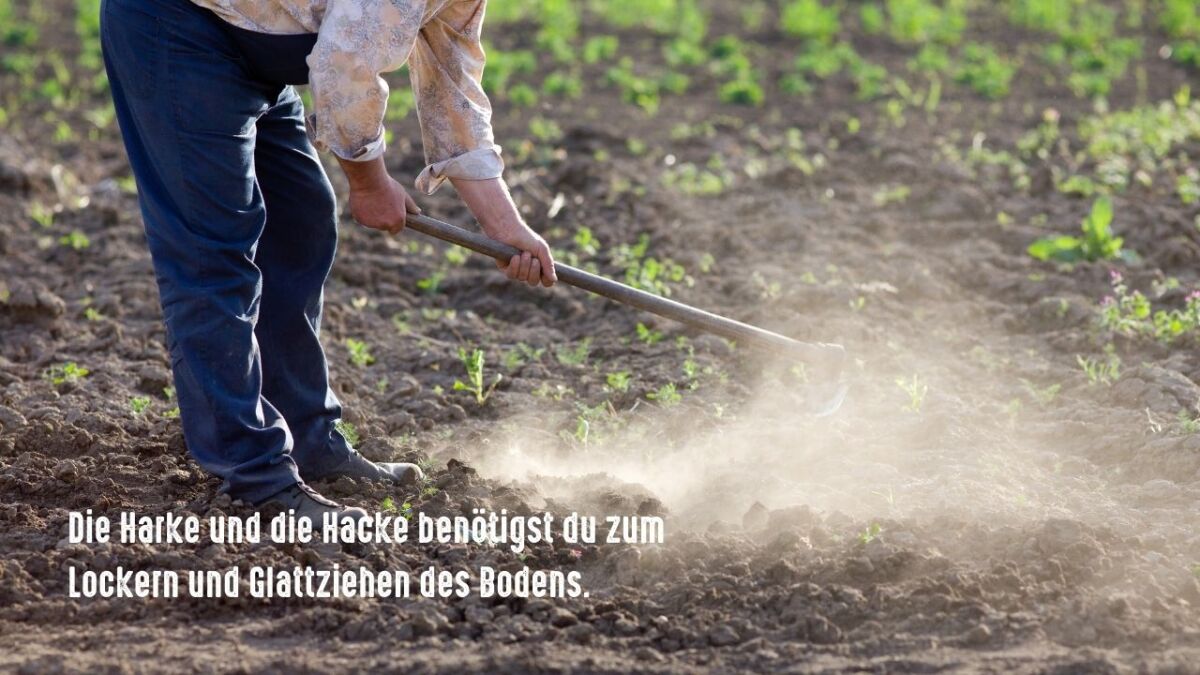
Before you try to break them down, make sure your soil is moist enough. With a hoe and rake, you can easily crumble them and level them with the remaining soil.
In addition, roots or weeds can be removed from the ground with a rake. For watering, you will need a watering can or a garden hose with an attachment.
My recommendation: When it comes to the rake, go for the KADAX Metal Rake, and for the hoe, you can choose the KADAX Metal Hoe and/or the WOLF-Garten Double Hoe.
Watering Can
Generally, the watering can is the tool that should always be within reach and is used the most.
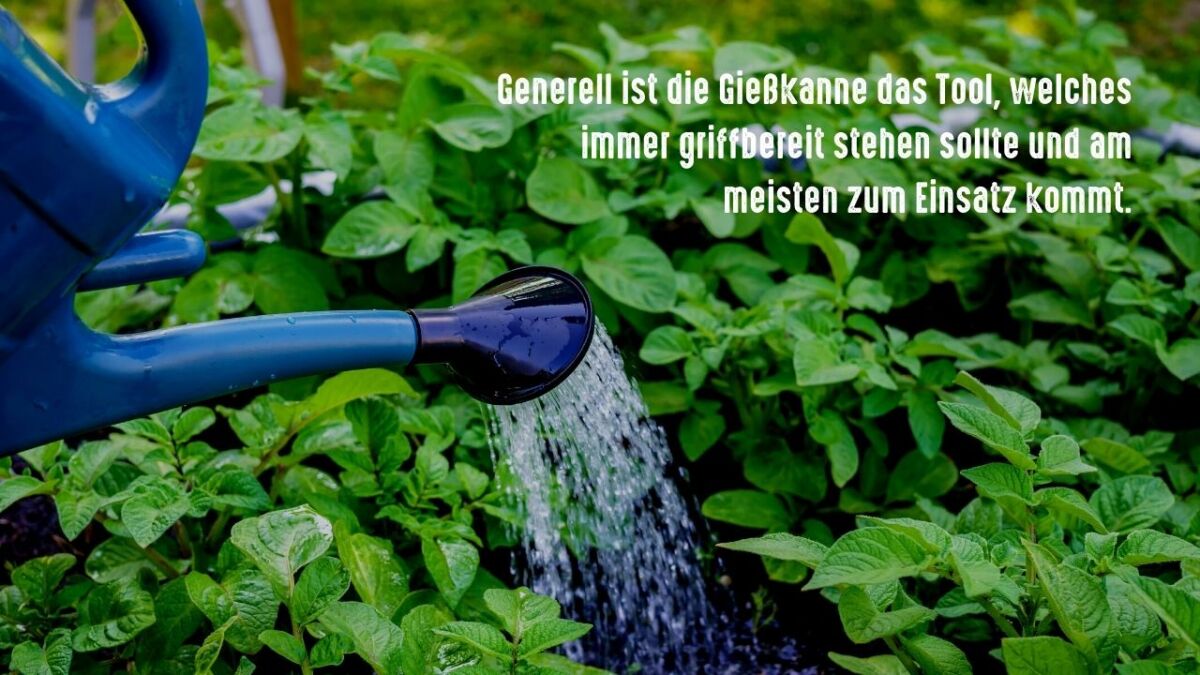
There are 2 basic types of watering cans, plastic or metal. There are hundreds of styles, colors, sizes, and nozzle options.
- Plastic watering cans can be lighter than metal ones, but they don't last as long.
- Metal watering cans should be galvanized to resist rust. Also consider the size of the watering cans in relation to your strength, as one liter of water weighs 1 kilogram.
- The handle position should allow you to carry a full watering can and also tilt it for easy pouring.
- Designs with two handles provide better stability for children or older gardeners.
- You may need two: a larger one with a sprinkler head for outdoor use and a smaller version with a long neck for indoor plants.
Water is essential for the life in your garden. To help the plants during periods of drought or longer absence, you can fill 5-liter bottles with water and place them upside down, without the lid, in the soil between the plants.
No need to worry, the moisture will not be released all at once, but will gradually seep away as needed. This ensures that your plants do not wither, but are adequately nourished.
There are watering cans aplenty, but my tip is to get two right away, like the Set of Two Watering Cans 10L Anthracite. These are two 10 liter watering cans. If you're looking for a larger one with 14 liters, then go for this watering can.
Garden shears
Occasionally, it is important to prune your plants. Whether it's the suckers on tomatoes or the overgrown hedge and wilted flowers, you definitely require a pair of pruning shears for that.
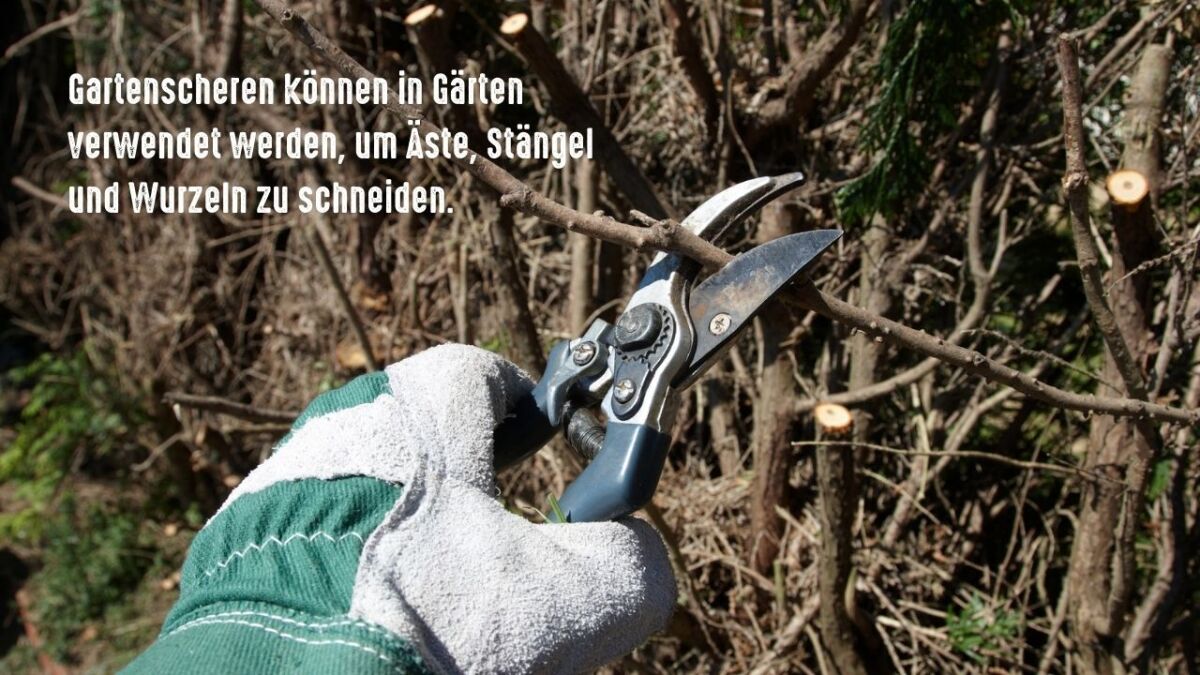
Suckers always grow between the stem and leaf axis. They draw moisture and nutrients that your tomato plant actually needs to form fruits. That's why you should remove these shoots.
To prune the suckers, I have the following tip for you: don't throw them away afterward, but instead put them in moist potting soil. They will develop roots and thus new tomato plants will emerge. This way, you guarantee yourself a higher yield.
Many flowering plants, like the carnation, tend to produce new blooms after the first flowering if you cut off the withered flowers.
Bushes and hedges grow more beautifully and fuller when they are regularly pruned.
With wine, the energy saved through pruning flows into grape formation and affects their size. Prune the vine about 30 cm after the grapes have formed.
This creates a win/win situation for you and the plant. You get large grapes and your vine has enough air to grow stronger.
Fruit trees and berry bushes tend to produce an excessive amount of water shoots. These nutrient thieves also need to be removed. You can identify them by their usually unbranched, straight, and long growth.
There are no flowers or fruits on them. However, in order for your shrub to produce enough fruits, you need to remove these unnecessary shoots.
Recommendation: Go for branded scissors, such as the Gardena Classic for plants. For trees and branches, it's better to use the Gardena Garden Shears B/S XL. The Fiskars Garden Shears are excellent for small plants and precise due to their shape.
Garden hose with adjustable nozzle
Water is the foundation of life for your garden, and it is important that your garden hose can reach and spray every area.
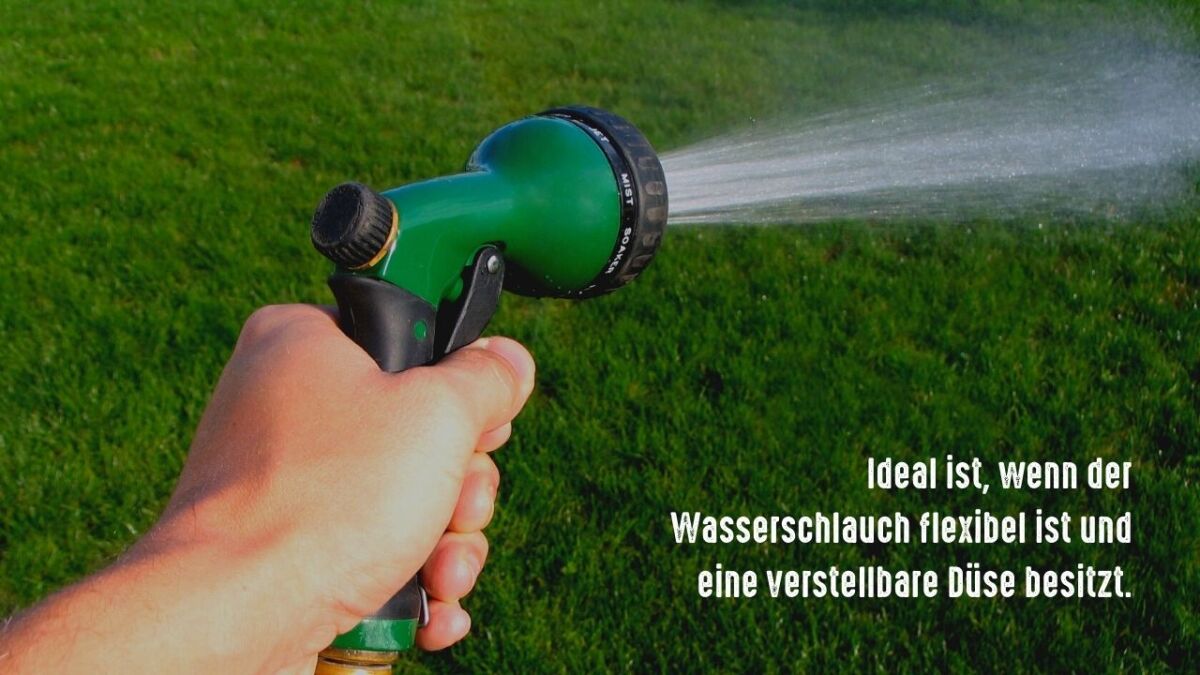
- An adjustable nozzle gives you control over water pressure and spray radius. Estimate the length you need for your hose before purchasing.
- Hose length affects water pressure - the longer the hose, the lower the resulting pressure.
- Vinyl hoses are lighter and more affordable, but they are more prone to kinking and don't last as long as rubber hoses.
- Store hoses coiled up and protect them from direct sunlight. Storing them with kinks can lead to weak spots.
I recommend the Gardena textile hose, it is flexible and super easy to use. A slightly cheaper option is the TRESKO® flexiHose.
Wheelbarrow
If your garden has extra soil that needs to be moved, compost or mulch that needs to be added to garden beds, or any other heavy lifting and moving project, a wheelbarrow can help you transport hundreds of kilos.
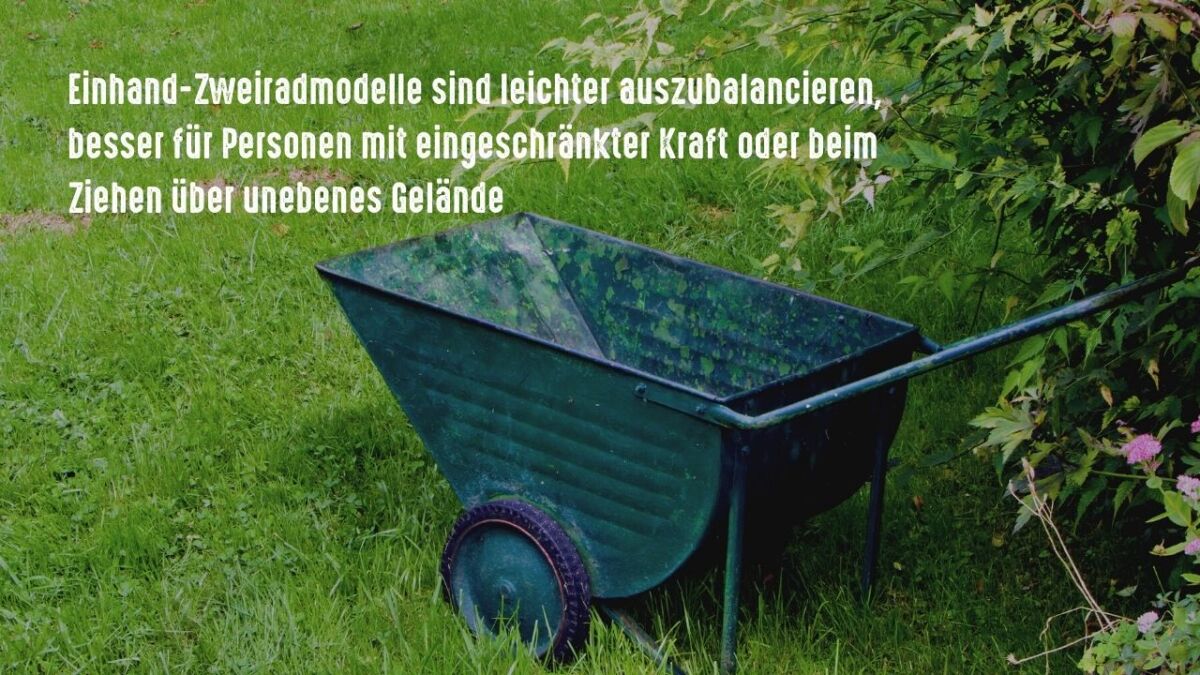
- Conventional models with two handles and single wheels can have difficulty balancing heavier or unevenly distributed loads.
- One-handed two-wheel models are easier to balance, better for individuals with limited strength or when pulling over uneven terrain.
- One-handed wheelbarrows can be pushed or pulled with one hand.
- Store the wheelbarrow clean and dry to avoid rust.
- Keep the tires inflated to make it easier to drive.
I recommend the VonHaus wheelbarrow with 78 liters. The single handle makes pushing, pulling, and emptying easier. If you prefer a different model, then go for the DEMA Duo wheelbarrow.
Protection is important, so let's talk about it
You need to take care not only of your tools, but also your knees and joints.
If you spend several hours in a kneeling position all day long, it can become painful.
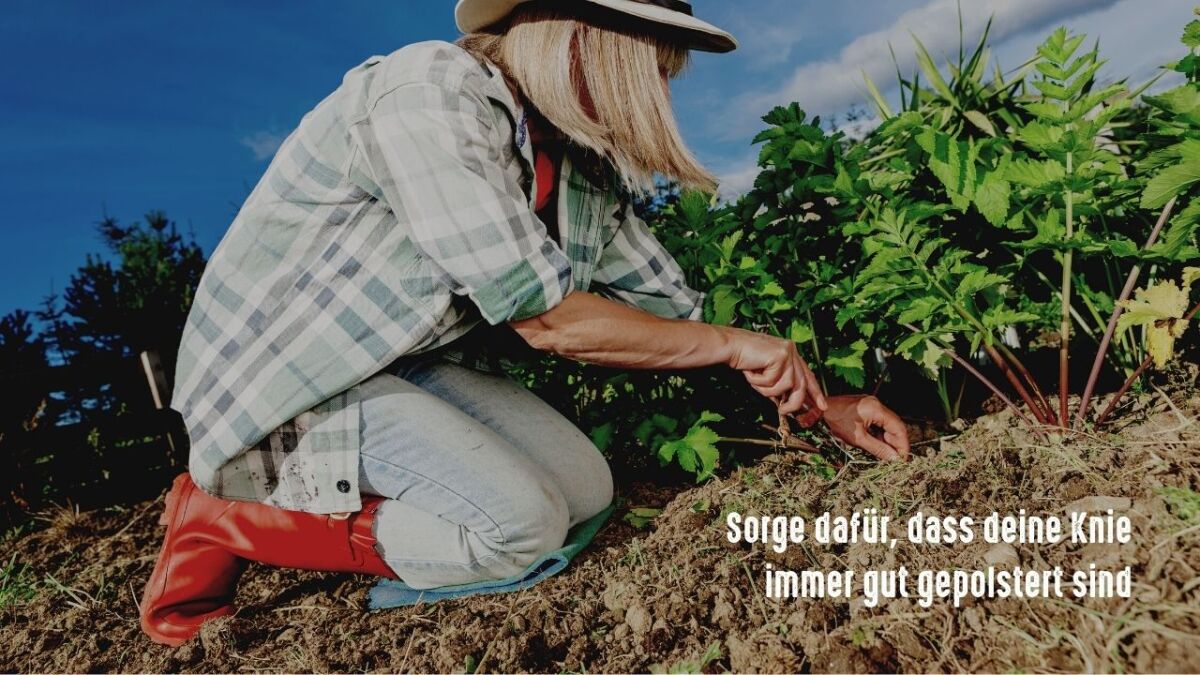
So make sure that your knees are always well padded. You can get knee-friendly cushions made of a firmer foam at any well-stocked household goods store. Equipped with these, you prevent sore knees and avoid the painful pressure from pebbles or thorns.
You can get knee pads for this, like the com-four® knee pads for gardening, which you attach to your knees, or you can use a padding to put underneath your knees.
Moreover, the toes and the soles of the feet need to be protected. If you try to dig with the wrong footwear and too thin soles, you will understand what I mean.
If you have pruned roses or blackberries and there is a broken thorn stuck in your sole, you will feel it. Therefore, get yourself durable garden shoes.
Unfortunately, many people keep getting injured due to their negligence towards nature.
Such accidents can be avoided if you observe your surroundings attentively and keep in mind that we are doing something with gardening that changes this environment.
After all, there are entirely different forces at work here, and where there is planing, there are also wood chips.
If you work in the sun for a long time, make sure to protect your head
What applies to playing children also applies to you in this case. Protecting your head helps prevent sunstroke.
Therefore, always wear a hat or cap when exposing yourself to the scorching sun while gardening. Your circulation will thank you.
Furthermore, make sure to take breaks and drink enough. Because in addition to sunstroke (affects the head locally), working in high temperatures also carries the risk of heat stroke (affects the whole body, usually requiring intensive care).
You're not doing yourself or your garden any favors if you suddenly find yourself lying among the carrots, knocked down by the sun due to overestimating yourself.
So always know your limits. If you notice that your attention is waning or your body is reacting in another way, then take a break.
Trending: Protecting Hands
Your hands are the most important when it comes to gardening. Therefore, you also need to protect them from injuries accordingly.
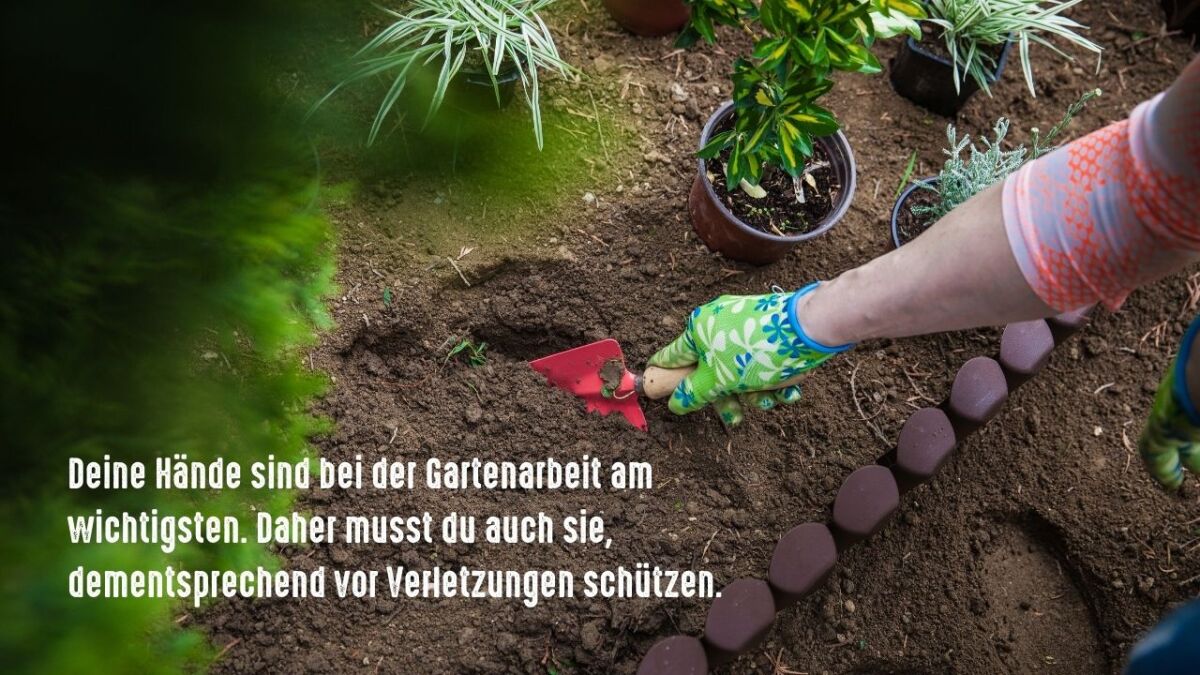
Cuts, scratches, and the like are unavoidable. However, you can reduce their number by wearing gloves.
Not everyone can work with it, and I am also one of the people who do not like the feeling on their hands.
Unfortunately, we can't avoid it at least for some gardening tasks. In the battle with thorny hedges, for example, they prove to be excellent allies.
Anyone who has ever touched a nettle or had one of the numerous thorns from blackberries on their finger knows what I'm talking about.
Recommendation: Get yourself the Gardena Planting and Soil Gloves and make sure to choose the right size when purchasing. Alternatively, you can use the ACE Protective Gloves in an affordable pack of three.
Create a compost bin
To get good garden soil, you need a compost bin. Building one is not as difficult as it may initially sound.
In principle, it is nothing more than a rectangular box that collects all the green waste and organic kitchen waste.
This also allows you to live more sustainably, as eggshells or banana peels contain potassium, calcium, and vitamins.
With coffee grounds, phosphorus and nitrogen are added. So you don't have to throw kitchen waste in the trash anymore, but can enrich your garden with it.
Ultimately, by creating the compost, you determine the nutrient composition of your soil.
From Zero to Hero: Tips for Gardening
If you find feeding traces on your cabbage, your herbs, or your salads, then lie in wait on a rainy day. The culprit that can destroy your entire harvest is the common slug.
You can fight them, throw them over the fence to the neighbor, or simply catch them and put them to useful work.
In general, snails eat dead plant matter. Collect as much of it as you can and put it on your compost.
There they will accelerate the process of conversion and help you achieve faster high-quality, nutrient-rich soil. This will turn pests into useful garden helpers.
If you resort to chemical warfare, unfortunately you also alter the fauna of your garden.
Not only moles, but also hedgehogs love slugs. So if you spread slug pellets that kill the slugs, you also poison the beneficial creatures that have slugs on their menu.
There is always another way that does no harm. Let's go back in time and look at how work was done 500 years ago, when there were no chemical aids available, maybe we can find the path to harmony with nature.
Because the problems were the same and back then, people knew more or less how to help themselves. So it's worth occasionally delving into old books, like those by John Seymour, on the subject.
Knowledge is everything - learn through practice
The more you know about gardening, the better you will succeed in practice.
"Learning by doing" is always the best method to find out how something works. Your interest and knowledge of the necessity are also important tools.
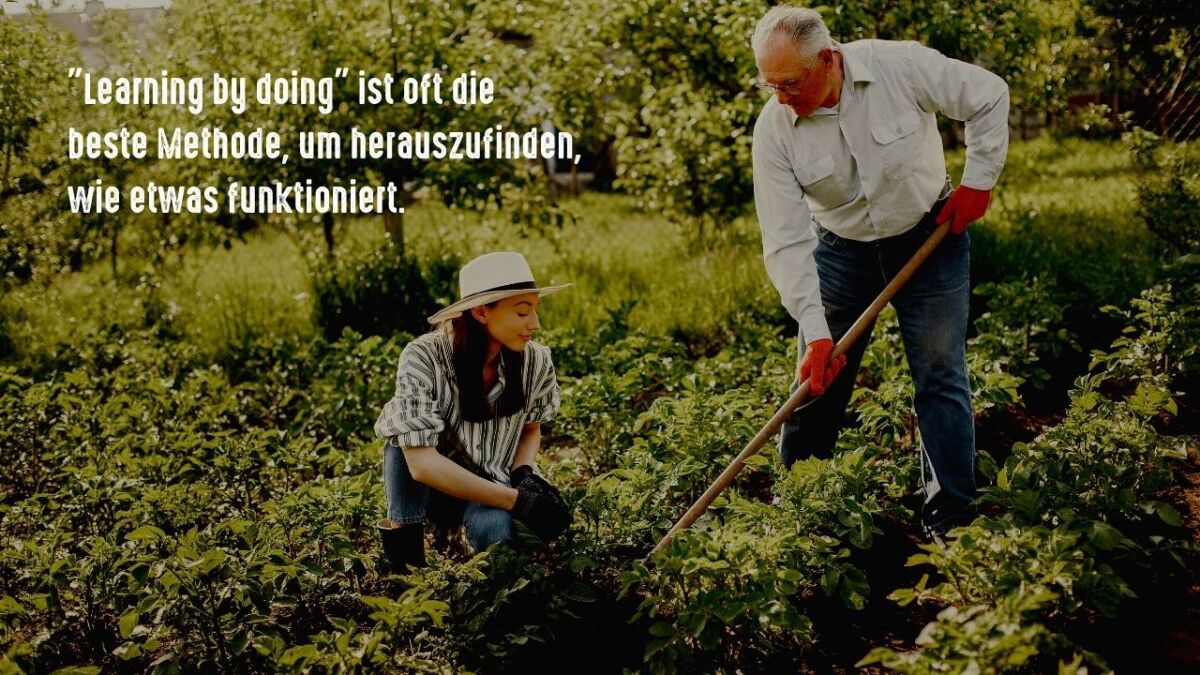
One of the most important sentences I have ever heard in my life is:
What you can steal with your eyes is yours, if you have implemented it with your hands.
There is so much potential and so much truth in that. In a time when we have access to knowledge like never, learning is also as easy as never.
YouTube, Pinterest, Instagram, and a whole horde of people showing us how things work.
Equipped like this, nothing can really go wrong, right?
Try different techniques, refine them, make them your own, and get started implementing the newly acquired knowledge.
The only one who can stand in your way is yourself. Once you understand that, you will be able to achieve a great deal.
Conclusion: Good devices and proper maintenance of the devices are key to success
In summary, I want to tell you that if you have the mentioned tools, you have a good starter set for self-sufficiency.
Of course, preservation, and storage (such as a root cellar) are also part of it, but this topic is too big to only touch on it briefly.
And before you can start with it, you first have to have grown something.
Storing and regularly maintaining your devices is a guarantee for your success in your work in the garden.
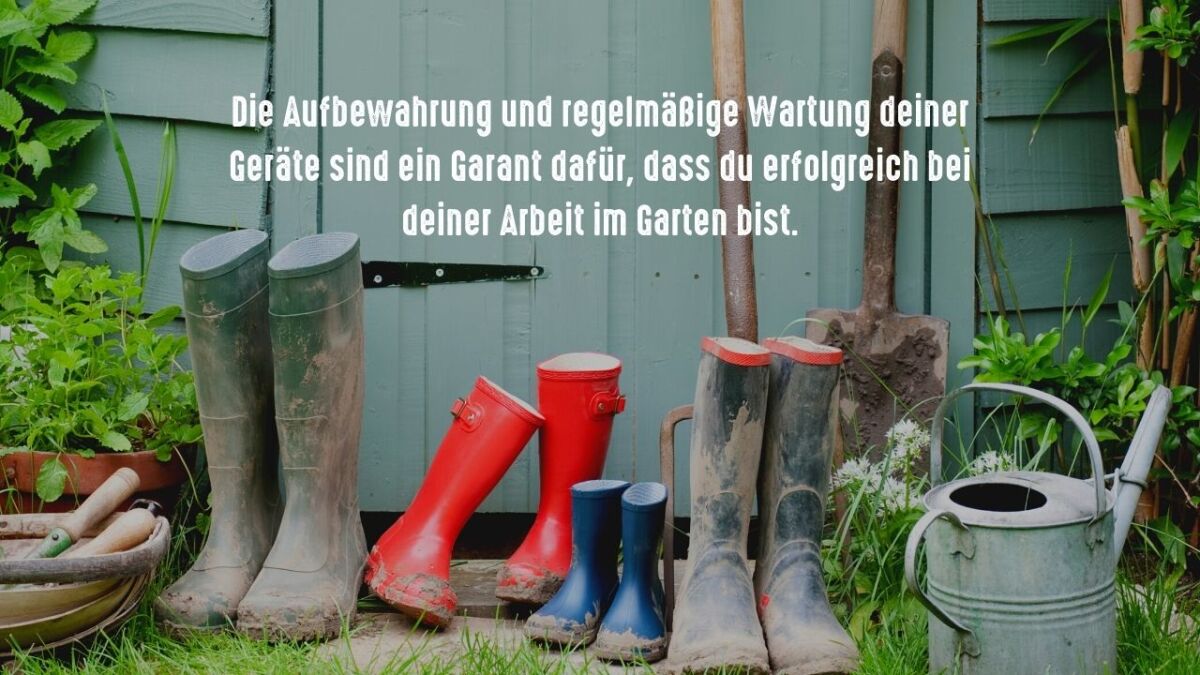
Without suitable and, above all, intact tools, you could mean well all you want - you simply wouldn't have a foundation. So pay attention to your tools.
Storage should be dry and clean. Any tool will be affected eventually by dirt and moisture.
So before you buy shovels and co., you should check the options available to you for storage.
More durable than wood, for example, is plastic, and nowadays, numerous providers offer you good opportunities to find alternatives to wooden handles.
Here you can also look at recommendations in advance and then consciously choose one of them.
My tip: Always heed user recommendations, not those of the seller.
I wish you success and a bountiful harvest.


Author of the guide
Martin Gebhardt
Hey, I'm Martin. On my blog, you will learn the basics and numerous details about living in the wild. I think survival, bushcraft and the good life in nature are the keys to happiness. Find me here on Instagram or on YouTube. You can find more about my mission on the About Me page.
Was this guide helpful?
7 people found this guide helpful.
5.00 out of 5 points (7 Ratings)
Comments (0)
This post may contain affiliate links. So if you click on the links and make a purchase, I will receive a small commission at no additional cost to you. Click here, to learn more about it.


